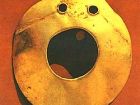THE HOTNITZA TREASURE - THE OLDEST GOLD IN BULGARIAN LANDS
THE HOTNITZA TREASURE
THE OLDEST GOLD IN BULGARIAN LANDS
THE OLDEST GOLD IN BULGARIAN LANDS
By some unwritten rule most of the historic treasures of art in our lands were discovered by chance, during agricultural or building activities, away from old or modern settlements.
One exception is the Hotnitza Treasure, interesting in many respects.
It is a scientific fact that near the village of Hotnitza, Veliko Turnovo region, there is an old prehistoric settlement.
For that reason, during the period 1956-1959 archeologists from the Turnovo Historical Museum started archeological excavations and uncovered relatively well-preserved dwellings of the ancient population on our territories.
These dwellings consisted of one room, built of wooden stakes and walls made of small branches and pasted over with mud.
There was scanty furniture in the dwellings, consisting of clay vessels and instruments of stone, bone and flint. There were small seats along the walls and a fireplace occupied one of the corners.
All the finds discovered during the excavations indicate that the village belongs to the end of the Neolithic period, about 4000 years BC.
There are similar dwellings all over the Balkan Peninsula.
This is the reason why archeologists are surprised by the unexpected find in one of the buildings.
On the floor they found a heap of gold objects, which weighed about 350 g. This small treasure consistual form. It turned out that the treasure remained in the earth after the shanty building was destroyed by fire. This was definitely the earliest find of gold objects in Bulgarian lands.
Archeologists are faced with a question — what is the nature of this treasure, so unusual for this early period, when people used most primitive instruments?
The gold rings were obviously used for a necklace, but an unusual one. This necklace, scholars suggest, had a magic function and was worn by some magician. He no doubt used it in cult rituals and it served him as an amulet.
The 4 gold plates are direct confirmation of this.
They have oval shape with a round hole in the middle, above which there are two additional holes (only one of the plates has three).
It is believed that this was the way to represent the human face.
An additional proof is the small oval piece standing out over the oval plate. It can be interpreted as a cap or some specific covering of the head.
Scholars are almost unanimous that these schematic images had some supernatural functions for their creators - they are spirits or primitive gods. They are related to the idols of that period, made of bone, ceramics, and sometimes of stone or marble. Therefore the whole find must have belonged to some priest and the dwelling itself could be defined as a sanctuary of gods unknown to us.
Not long after this discovery, in 1958, near the village of Hotnitza was found a workshop for prehistoric idols of bone. This is proved by the great number of primitive small idols in one of the rooms made of bone. There are also some unfinished figures. Why they were left unfinished is not quite clear. Probably the reason was the fire that destroyed the whole village. The inhabitants fled away and didn't return to their dwellings.
The full excavation of the prehistoric village near Hotnitza uncovers important aspects of the spiritual life of the first inhabitants of our territories.
The gold treasure found there is not important only as valuable metal, but also as a proof of the well-developed religious system of this community.
There is no doubt that people of that period already had a clear notion of the existence of this world, the earthly one, and the other one, which they inhabit after their death. Supernatural forces rule both worlds. This notion can be viewed as pre-religious and it formed the foundation of future world religions — Christianity, Islam and Buddhism.







